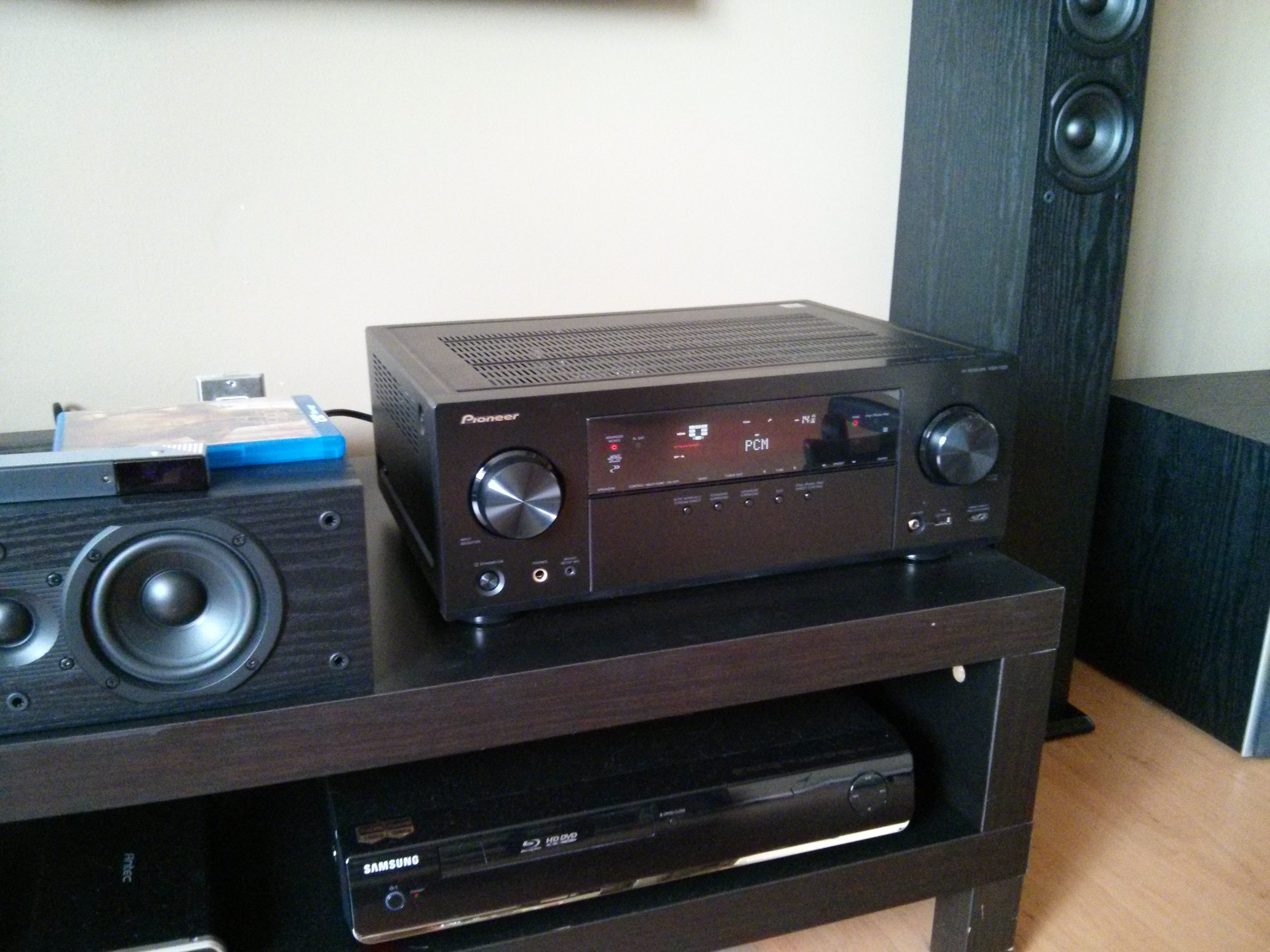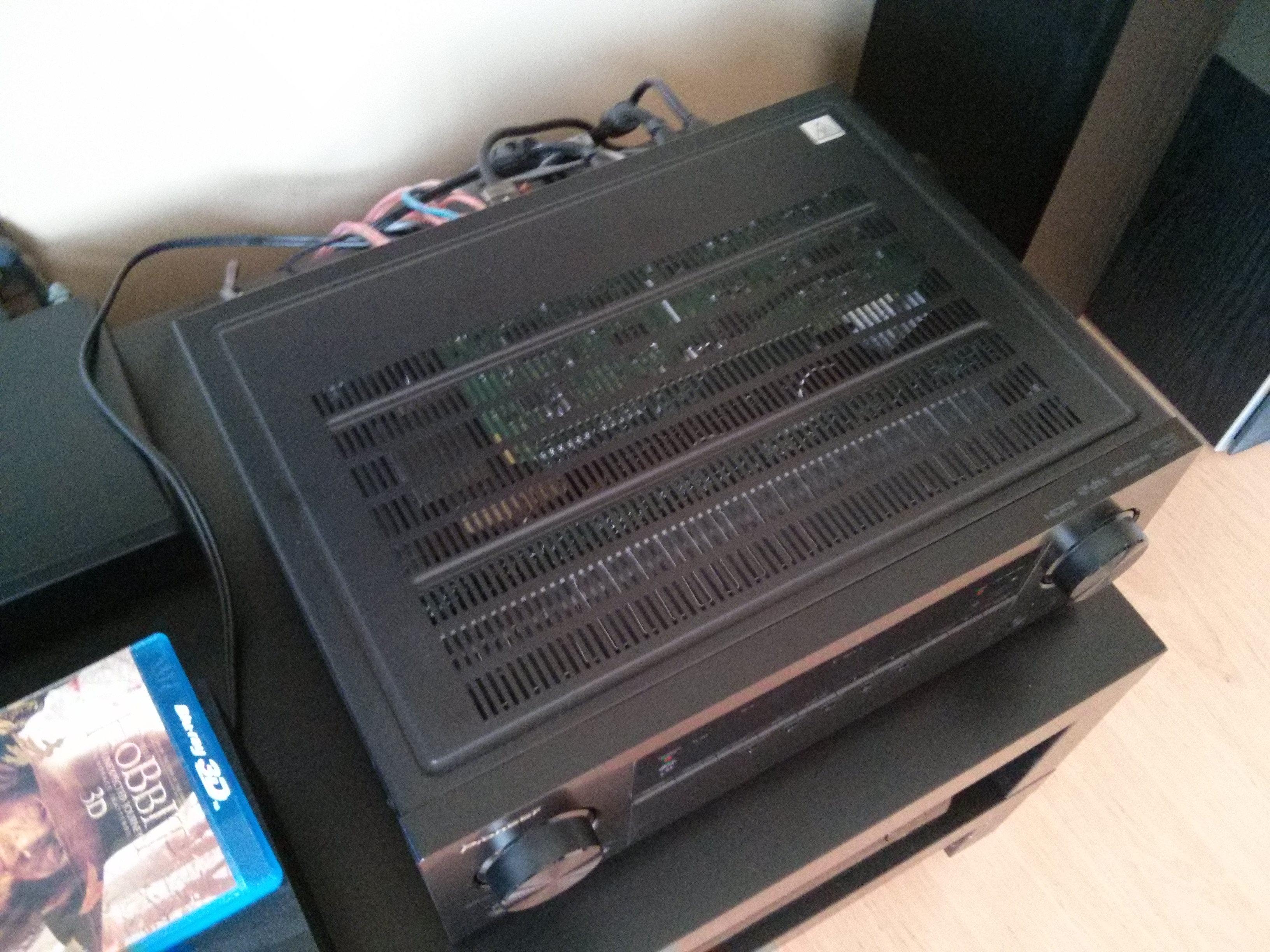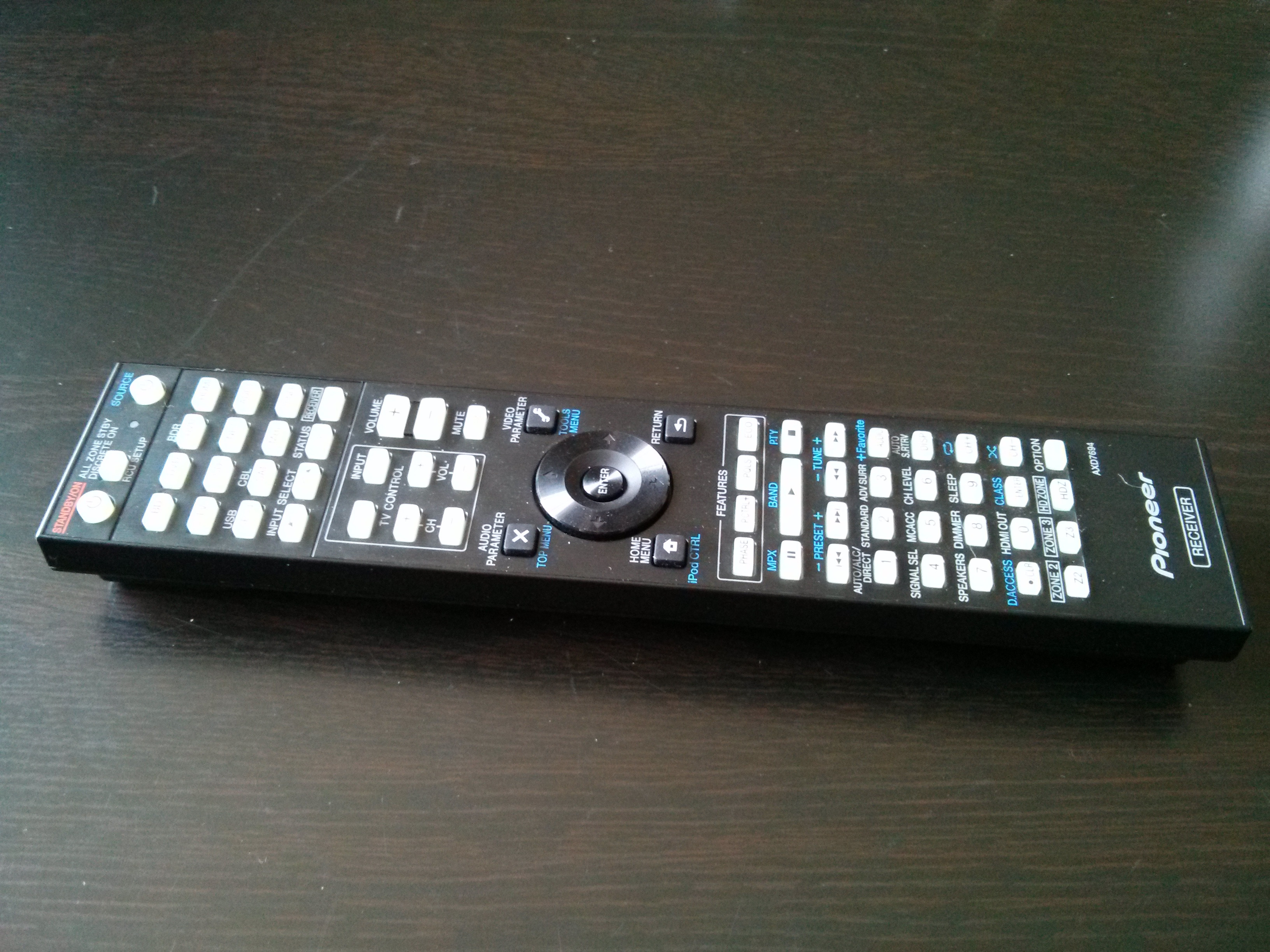The Pioneer VSX-1123-K, a flagship non-Elite series receiver from 2013, packed a powerful punch with a host of features aimed at both audiophiles and home theater enthusiasts. This receiver boasted a wide array of connectivity options and functionalities, making it a versatile centerpiece for any entertainment system. From wireless streaming capabilities like Airplay and HTC Connect to advanced audio processing and multi-zone functionality, the VSX-1123-K aimed to deliver a premium experience.
One of the standout features of the Pioneer VSX-1123-K is its comprehensive codec support, including lossless audio formats, ensuring high-fidelity sound reproduction. It also offered upscaling to HDMI and 4K resolutions, catering to future-proofing display technologies, along with Audio Return Channel (ARC) and 3D capability for enhanced home theater integration. With dual HDMI zones and audio zones, the VSX-1123-K provided flexibility for multi-room setups. Power output was rated at 90 watts per channel into 8 ohms and 165 watts per channel into 6 ohms, although real-world performance should always be critically evaluated. Notably, it employed Class A/B amplifiers, known for their balance of sound quality and efficiency.
 Pioneer VSX-1123-K Receiver Front Panel
Pioneer VSX-1123-K Receiver Front Panel
Unlocking Optimal Sound with Pioneer MCACC
A cornerstone of the Pioneer VSX-1123-K’s audio prowess is its proprietary MCACC, or Multi-Channel Acoustic Calibration System. This sophisticated software suite is designed to optimize the receiver’s audio output to match the specific acoustic properties of your listening environment. The process involves placing a microphone (included with the receiver) at ear level in your primary listening position. MCACC then analyzes test tones emitted through your speakers to automatically adjust settings, ensuring the best possible soundstage and sonic balance for your room.
For initial setup, it’s recommended to run MCACC in Full Auto mode with ALL CH ADJ and appropriate speaker configurations like Normal (SB/FH), Normal (SB/FW), or Speaker B, unless using THX certified speakers. A minimum 5.1 speaker system is required for this comprehensive calibration. The reviewer utilized Speaker B setting during their MCACC setup. After running MCACC, the results can be copied to multiple memory slots for backup and easy A/B comparison while tweaking individual settings. MCACC also offers a valuable diagnostic feature, alerting users to potential speaker phase issues, ensuring correct speaker wiring for optimal performance.
 Pioneer VSX-1123-K Back Panel Connectivity
Pioneer VSX-1123-K Back Panel Connectivity
Thermal Efficiency and Design Considerations
The Pioneer VSX-1123-K demonstrates effective heat management, a crucial factor for AV receivers, especially those employing Class A/B amplification. The receiver’s chassis incorporates substantial ventilation gaps, facilitating efficient heat dissipation. In practical use, the VSX-1123-K generates considerably less heat compared to some previous generation receivers. While the reduced heat output is a positive aspect, it’s still generally advisable to avoid placing objects directly on top of the receiver to ensure adequate airflow and prevent potential overheating, maintaining long-term reliability.
Understanding Crossover Frequency for Bass Management
Crossover frequency, often abbreviated as X.Over, is a critical setting for optimizing bass performance in a home theater system. It dictates the frequency point at which low-frequency effects (LFE) are directed to the subwoofer. Frequencies above the crossover point are filtered out from the subwoofer channel. It’s worth noting that audio studios often mix soundtracks to accommodate systems without subwoofers, embedding LFE information into other channels.
Setting the subwoofer mode to “Plus” on the VSX-1123-K bypasses the crossover setting, routing all bass frequencies to the subwoofer. Conversely, configuring front speakers as “Large” and the subwoofer to “Yes” sends the full frequency range of the front left and right channels to the front speakers. For instance, with front speakers having a frequency response down to 37Hz and a subwoofer covering 37Hz to 200Hz, setting an 80Hz crossover with “Large” speaker setting means front speakers handle frequencies above 80Hz, while the subwoofer manages the LFE channel up to 80Hz. The 80Hz crossover is popular because Dolby LFE typically operates at 80Hz and below, and human hearing perceives frequencies below 80Hz as non-directional. While higher crossover points like 120Hz or even 150Hz can capture the full LFE track, careful consideration of speaker capabilities and room acoustics is essential for optimal integration. For further in-depth information on MCACC and crossover settings, resources like the AVS Forum MCACC thread offer detailed discussions and expert insights.
Navigating Sound Modes: DIRECT, PURE DIRECT, ALC, and AUTO SURROUND
A common point of confusion for new Pioneer receiver owners lies in understanding the various sound modes. The VSX-1123-K offers several key modes, each with distinct sonic characteristics. DIRECT mode prioritizes source fidelity, applying minimal processing beyond MCACC calibration and Phase Control. PURE DIRECT takes this a step further, minimizing digital processing to the absolute minimum, bypassing EQ and Standing Wave correction, relying solely on channel level and distance settings from calibration. ALC, or Auto Level Control, is designed for late-night listening, normalizing channel levels to prevent loud sounds from being overpowering. AUTO SURROUND intelligently selects the most appropriate surround mode based on the input signal.
The reviewer personally favors DIRECT mode for general listening, appreciating its balance of source accuracy and MCACC enhancements, finding it particularly engaging for movie soundtracks. Subjectively, compared to a Harman Kardon AVR 2650, the Pioneer VSX-1123-K is praised for its balanced sound profile, avoiding a “boomy” bass and delivering a more refined overall sonic signature. After MCACC calibration and fine-tuning, the VSX-1123-K delivers a more immersive and theater-like audio experience compared to the previous Harman Kardon receiver.
iControlAV2013 App: Wireless Control and Streaming Convenience
The iControlAV2013 app for Android and iOS devices provides a convenient wireless control interface for the Pioneer VSX-1123-K. The app allows users to browse music libraries on DLNA servers and locally stored music on their mobile devices. The “Push Player” function emulates Apple’s AirPlay, enabling seamless music streaming from Android devices. Volume control via the phone’s volume rocker directly adjusts the receiver’s volume. A persistent notification icon provides quick access to music playback controls. The app’s network standby feature enables remote receiver power-on, facilitating convenient music playback initiation.
Beyond music playback, the iControlAV2013 app offers comprehensive control over receiver functions, including zone switching, source selection, volume adjustment, input switching, listening mode selection, balance, phase control, and bass/treble adjustments. It provides a visually intuitive interface for managing the receiver’s extensive feature set. While primarily used for music streaming by the reviewer, the app complements the physical remote for overall system control.
DLNA Server Connectivity and Network Streaming
DLNA (Digital Living Network Alliance) server compatibility is a significant asset of the Pioneer VSX-1123-K. It seamlessly integrates with media servers, enabling streaming of digital audio content. The reviewer utilizes Plex Media Server on a Linux-based home server, highlighting the receiver’s flawless DLNA connectivity. Lossless audio format support eliminates the need for transcoding, preserving audio quality during streaming. The review cautions against relying on Windows built-in DLNA server functionality, citing potential reliability issues and recommending third-party DLNA server applications like Plex, TVersity, or Twonky for more robust and universal performance.
 Pioneer VSX-1123-K Remote Control
Pioneer VSX-1123-K Remote Control
Remote Control and On-Screen Display (OSD)
The Pioneer VSX-1123-K remote control is feature-rich, offering a multitude of buttons for direct access to various functions. It can also function as a universal remote, learning IR codes from other devices, potentially simplifying control of an entire home theater setup. While described as lightweight and somewhat flimsy in build quality, the remote is praised for its responsive button presses and the inclusion of a receiver function lock, preventing accidental setting changes, particularly useful in households with children.
The on-screen display (OSD) prioritizes functionality over aesthetics. While not visually elaborate, the OSD provides clear and accessible menus for navigating the receiver’s settings and options, emphasizing practical utility over visual appeal.
Wired Connectivity, HDMI Features, and Zone 2 Functionality
The Pioneer VSX-1123-K offers extensive connectivity, including 7 HDMI inputs and analog-to-HDMI conversion with 4K upscaling capabilities. Dual HDMI Zone outputs enable routing different video sources to two separate displays. HDMI pass-through functionality allows the last selected HDMI source to be passed through to the display even when the receiver is powered off.
Zone 2 functionality allows for independent audio playback in a second zone. Configuration involves accessing the receiver’s menu, navigating to “System Setup,” then “Manual SP Setup,” and “Speaker System” to select ZONE 2. Subsequently, in “Other Setup,” “Play ZONE Setup,” set “Play ZONE” to ZONE 2. For HDMI Zone 2 output, HDZONE settings may require adjustment.
 RTFM – Read The F*** Manual
RTFM – Read The F*** Manual
Video Processing and Audio Return Channel (ARC)
The VSX-1123-K provides video adjustment options, including contrast, hue, and saturation controls, similar to its comprehensive audio settings. Audio Return Channel (ARC) functionality simplifies audio connectivity from ARC-compatible TVs, sending audio back to the receiver via the HDMI cable. ARC setup on the VSX-1123-K is described as straightforward, requiring enabling “Control On” and “ARC On” in the receiver’s HDMI setup menu and activating the corresponding CEC (Consumer Electronics Control) feature on the connected TV (e.g., AnyNet+ on Samsung, SIMPLINK on LG). ARC functionality was successfully tested with Netflix, confirming Dolby Digital 5.1 audio playback. HDMI 1.4 or higher specification cables are required for ARC to function correctly.
| HDMI version | 1.0 | 1.1 | 1.2x | 1.3 | 1.3x | 1.4x | 2.0 |
|---|---|---|---|---|---|---|---|
| sRGB | Yes | Yes | Yes | Yes | Yes | Yes | Yes |
| YCbCr | Yes | Yes | Yes | Yes | Yes | Yes | Yes |
| 8 channel LPCM, 192 kHz, 24-bit audio capability | Yes | Yes | Yes | Yes | Yes | Yes | Yes |
| Blu-ray Disc and HD DVD video and audio at full resolution[F] | Yes | Yes | Yes | Yes | Yes | Yes | Yes |
| Consumer Electronic Control (CEC)[G] | Yes | Yes | Yes | Yes | Yes | Yes | Yes |
| DVD-Audio support | No | Yes | Yes | Yes | Yes | Yes | Yes |
| Super Audio CD (DSD) support[H] | No | No | Yes | Yes | Yes | Yes | Yes |
| Deep color | No | No | No | Yes | Yes | Yes | Yes |
| xvYCC | No | No | No | Yes | Yes | Yes | Yes |
| Auto lip-sync | No | No | No | Yes | Yes | Yes | Yes |
| Dolby TrueHD bitstream capable | No | No | No | Yes | Yes | Yes | Yes |
| DTS-HD Master Audio bitstream capable | No | No | No | Yes | Yes | Yes | Yes |
| Updated list of CEC commands[I] | No | No | No | Yes | Yes | Yes | Yes |
| 3D over HDMI[142] | No | No | No | No | No | Yes | Yes |
| Ethernet channel | No | No | No | No | No | Yes | Yes |
| Audio return channel (ARC) | No | No | No | No | No | Yes | Yes |
| 4K resolution support[143] | No | No | No | No | No | No | Yes |
There’s a note regarding potential HDMI board strain with ARC, suggesting optical connections as an alternative, although the validity of this concern is uncertain. Notably, the reviewer experienced resolution of previous HDMI flicker issues encountered with a Harman Kardon receiver after switching to the Pioneer VSX-1123-K, suggesting potential HDMI board issues in the older receiver.
Maximizing Audio Potential: Beyond Plug and Play
While the Pioneer VSX-1123-K offers good sound quality even with basic setup and Advanced MCACC, truly maximizing its audio capabilities requires exploring its extensive sound customization options. Experimenting with settings beyond basic levels and balance, such as adjusting the EQ, is encouraged to fine-tune the sound to individual preferences and room acoustics. Investing time in understanding and exploring the receiver’s features is key to unlocking its full potential and achieving the best possible home theater experience. Resources like the AVS Forum MCACC thread are invaluable for gaining deeper insights and troubleshooting tips from experienced users and enthusiasts.
Conclusion: A Feature-Rich and Powerful Receiver
The Pioneer VSX-1123-K is rated 8 out of 10, acknowledging minor drawbacks such as potentially unclear instructions and confusing crossover settings for beginners. However, its exceptional sound quality and comprehensive connectivity options are highlighted as major strengths. For users willing to invest time in setup and customization, the VSX-1123-K offers a compelling combination of features and performance, making it a strong contender in its class.
This review is based on original article content and aims to provide an enhanced, SEO-optimized version for an English-speaking audience.
